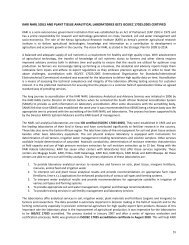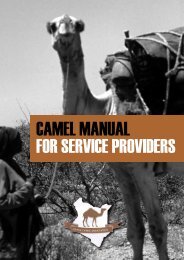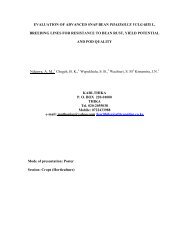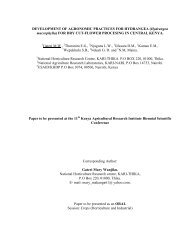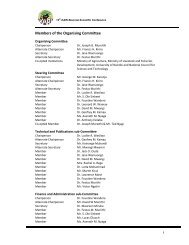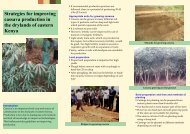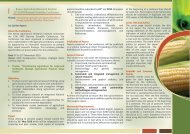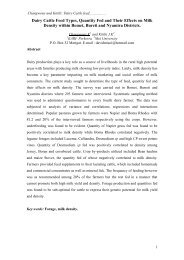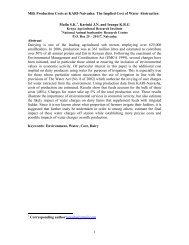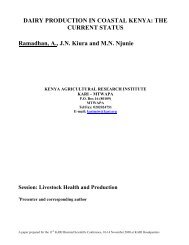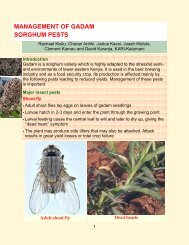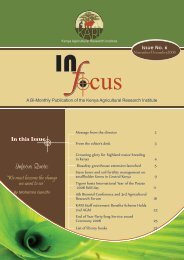January - June 2008 - Kenya Agricultural Research Institute
January - June 2008 - Kenya Agricultural Research Institute
January - June 2008 - Kenya Agricultural Research Institute
You also want an ePaper? Increase the reach of your titles
YUMPU automatically turns print PDFs into web optimized ePapers that Google loves.
(LTT) at KARI-Kabete has also continued to demonstrate<br />
yield responses to inorganic, organic fertilizers and their<br />
integration. The LTT further offers a range of soil<br />
management options that smallholder farmers can choose<br />
from depending on their availability and socio-economic<br />
factors associated with the different inputs which are likely<br />
to differ from one site to the other.<br />
Fertilizer demand and supply<br />
Food production and soil fertility management in <strong>Kenya</strong><br />
is mainly undertaken by the small-scale farmers who<br />
represent about 85 % of the population and live in the<br />
rural areas. However, <strong>Kenya</strong>’s growth in fertilizer<br />
consumption covers both food and cash crops such as<br />
tea, coffee, and sugarcane. Fertilizer use rose by 35% over<br />
a 10-year period (from 1995 to 2004) while the total<br />
consumption rose from a mean of 180,000 in the 1980s to<br />
250,000 t yr -1 in the 1990s and to over 350,000 t yr -1 in the<br />
2004/5 period. The proportion of small farmers using<br />
fertilizer varied considerably but generally increased from<br />
10% in the dry lowlands to over 85% in central Province<br />
and high rainfall potential zones of the North Rift valley<br />
Province. This expanded fertilizer growth is mainly<br />
attributed to several factors including:<br />
• A relatively stable fertilizer policy since 1990 which<br />
has attracted over 10 importers, 500 wholesalers and<br />
7,000 retailers;<br />
• A greatly increased network of fertilizer retailers in<br />
rural areas that expanded smallholders’ access to<br />
fertilizer, reduced transaction costs, and increased the<br />
profitability of using fertilizer;<br />
• Intense competition in importing and wholesaling;<br />
• Relative profitability of the horticulture market (96%<br />
of horticultural sales is for the domestic market)<br />
thereby raising farmers’ incentives to fertilize maize<br />
intercropped with horticultural crops.<br />
Potential for local/regional manufacturing and bulk<br />
blending<br />
Most of fertilizers used in the country are imported with<br />
the exception of single super phosphate (SSP) which is<br />
manufactured in the country by KEL Chemicals in Thika.<br />
The type and quantity of fertilizers used is dictated by the<br />
importers who determine what to import based on their<br />
own assessment of demand, weather conditions, credit<br />
availability and policy environment. There is noted<br />
interest in the marketing of raw Minjingu phosphate rock<br />
from Tanzania. Potassium has also been noted as an<br />
emerging limiting nutrient under continuous cropping.<br />
Potassium studies in western <strong>Kenya</strong> created a need for<br />
NPK fertilizers leading one company to produce a NPK<br />
blended fertilizer for sale specifically in <strong>Kenya</strong> (Kanyajua).<br />
Role of agro-dealers/private sector<br />
To improve food security and achieve desired growth,<br />
there is need to put in a public-private partnership<br />
framework that will raise awareness of technologies and<br />
inputs; improve their use efficiency; lower transactions<br />
of supplying inputs; improve linkages between importers,<br />
wholesalers and retailers and improve economies of scale<br />
in marketing of inputs at wholesale and retail levels. A<br />
survey conducted in <strong>Kenya</strong> indicated that when average<br />
distances to nearest fertilizer dealer declined from 8 to 4<br />
kms between 1997 and 2004, the volume, quality and<br />
agricultural inputs increased significantly. Sales rose from<br />
125,000 USD in April 2003 to 676,000 in April 2004. The<br />
study further showed that the agro-dealers have become<br />
important conduits connecting the rural poor with local<br />
and multi-national seed, fertilizer and agro-chemical<br />
companies. Thus the development of the agro-dealers is<br />
critical in accelerating the access of quality inputs to the<br />
rural poor<br />
Status of fertilizer information<br />
There is scarcity of data on the fertilizer use and demand<br />
by smallholders, which makes it difficult to assess how<br />
much fertilizer is used by small scale farmers compared to<br />
commercial farmers. <strong>Kenya</strong> is currently using an average<br />
of 31 kg of fertilizer, which may appear better than most of<br />
the other SSA countries. However, it is not clear as to how<br />
this amount is partitioned between smallholders and<br />
commercial farmers. However, national surveys indicate<br />
that fertilizer use by smallholder farmers is on the decline<br />
while most have stopped using fertilizers altogether or<br />
supplemented them with organic inputs. Evidence indicate<br />
that where fertilizers are still in use, the rates of applications<br />
are far below those recommended.<br />
Human capacity available and needs for research and<br />
development<br />
The national human capacity involved in soil health is<br />
about 500 who are at different levels of education starting<br />
from diploma to postgraduate level in agriculture. Most<br />
of these are limited to the <strong>Kenya</strong> <strong>Agricultural</strong> <strong>Research</strong><br />
<strong>Institute</strong> (KARI) and the local Universities with few NGOs<br />
focusing on soil health. This number is supplemented by<br />
others in the development sector from the Ministries of<br />
Agriculture and Environment as well as locally based<br />
international Centres (CGIARs).<br />
Available soil fertility restoration technologies ready for<br />
scaling-up<br />
Various technologies/strategies can be drawn from the<br />
Long Term Trial (LTT) at KARI-Kabete conducted for the<br />
last 32 years in addition to various other findings from<br />
experimental plots.<br />
Government policy on soil fertility management<br />
A draft fertilizers policy that identified causes of soil<br />
fertility decline and emerging challenges which were<br />
transferred into policy objectives was prepared and<br />
presented to the Government in 2006. It is also designed<br />
to encourage stakeholders to perform their roles in<br />
collaboration and enable them access factors of production<br />
and apply best management practices. Once passed by<br />
Parliament, the policy document will provide guidelines<br />
on the way forward for the restoration and maintenance<br />
of soil fertility to achieve sustained agricultural production.<br />
The Way Forward on the SHP of AGRA<br />
AGRA has contracted a team of international consultants<br />
to assist in developing a soil health program for Africa.<br />
Drs. Esilaba and Nyambati are working with that team to<br />
develop the program for <strong>Kenya</strong>.<br />
Highlighter No. 23<br />
11



